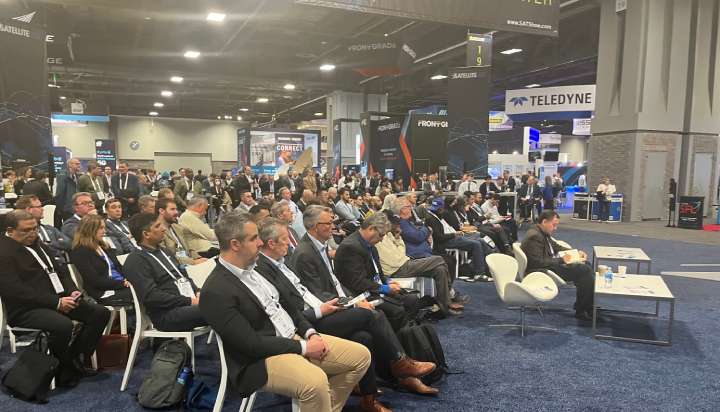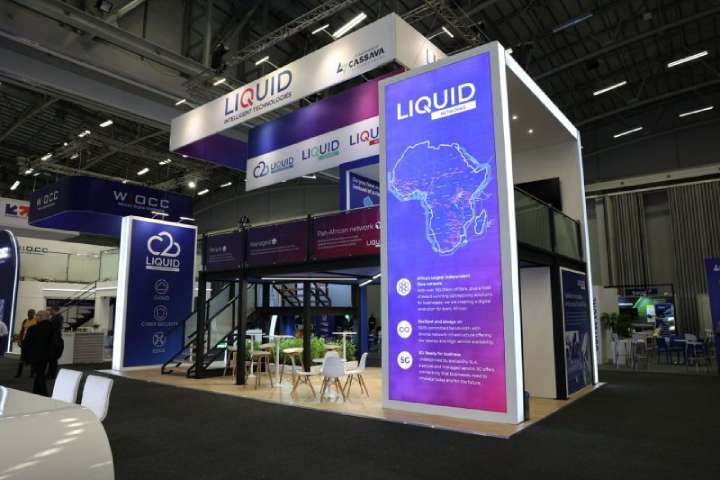WASHINGTON — The way satellite ground service operators and teleports provide commercial services must be altered to meet telcos’ elastic demand and flexible networks, according to a regional independent telecommunications service provider.
 Satellite 2023 was held in Washington, D.C. from March 13-16, bringing together industry leaders from around the world. (Source: Kratos)
Satellite 2023 was held in Washington, D.C. from March 13-16, bringing together industry leaders from around the world. (Source: Kratos)
Speaking on a panel about integrating software-defined networks (SDN) at Satellite 2023, Liquid Telecom Satellite Services CEO Scott Mumford explained that high MHz leases, rigid terms and inflexible networks may offer stability for satellite service providers, but it’s not an ideal partnership for telcos.
“I think the commercial models need to change drastically,” he said. “As we move towards a much more software-defined ground segment architecture and network architecture, that commercial model needs to change in line with that.”
Liquid is a regional telecom provider that supplies satellite, fiber and carrier services to MNOs, ISPs and businesses across Africa. Mumford emphasized the need for hybrid satellite-terrestrial communications networks, where a telco can call up satellite links on demand within an intelligent managed service offering. He cited fixed pricing models for MHz of bandwidth as a pain point for telcos and reflected the trend of customers requesting pay-as-you-go satcom bandwidth.
Price Down, Performance Up
Working more effectively with telcos was one of the themes across the Satellite 2023 conference. Panelists covered the topic explicitly in a session geared toward winning satcom business from telcos. It was also raised in a CEO session where leaders of established satellite operators assessed the addressable connectivity market.
“Connectivity is here to stay,” said Eutelsat CEO Eva Berneke. “If we as an industry can get satellites out of this niche of being too expensive to be something that is actually competitive in the telecom space, then we’re opening a totally different market.”
Developments over the last year have pushed satellite broadband connectivity to the mainstream. But the price of bandwidth and difficulties integrating with satcom networks continue to be a hurdle for telcos.
“Most of what we have to do is embrace the standards. If we do that, then we can leverage the same tools and technology the carriers already know and understand to make adoption easy,” Kratos Senior Vice President of Product Marketing Greg Quiggle said during the SDN panel. “If you look at what it takes to drive that adoption, part of it is making it easy for telco customers to consume [satcom]. We make it hard; we have to make it easy.”
Adopting telco service standards, such as Carrier Ethernet are viewed as a starting point for easier satcom integration, while software-defined networks are key to leveraging on-orbit capacity from high-throughput satellites and software-defined payloads. Panelists noted that those combined factors will drive a decline in the cost of satellite bandwidth, which has fallen significantly in recent years.
ALL.SPACE head of Pre-sales and Customer Solutions Brian Billman noted that “performance up and price down” will continue to be the best approach for satellite service providers to become a bigger part of the telecommunications market.
“If we’re able to adopt these standards and create business models like spot pricing, we’re going to see the prices continue to drop even more,” he said. “Improving performance will inherently come with software-defined networks and with network function virtualization.”
 The CEO of Liquid Satellite Services, the leading independent satellite service provider in Africa, highlighted the challenges telcos face in working with satcom providers. Image shows Liquid Intelligent Technologies at the 2023 Africa Tech Festival. (Source: Liquid Satellite Services/LinkedIn)
The CEO of Liquid Satellite Services, the leading independent satellite service provider in Africa, highlighted the challenges telcos face in working with satcom providers. Image shows Liquid Intelligent Technologies at the 2023 Africa Tech Festival. (Source: Liquid Satellite Services/LinkedIn)
In turn, network standardization is expected to drive faster innovation, a more competitive landscape and faster rollouts, particularly when network functions are virtualized and disaggregated from proprietary hardware.
“Once you’re on standard processing, anyone with a computer can develop products for that,” Billman continued. “And the user can choose to pick the best of those at any given time.”
A Heated Exchange About Vendor Lock
Frustration with proprietary systems has often been a part of doing business with satcom providers. That conflict tends to happen behind closed doors, but it spilled out into the open at Satellite.
In response to a question about vertically integrated companies, like Starlink, several panelists touted the importance of providing customers with the best solution for their use case and supporting multiple solutions, such as multi-orbit, multi-network connectivity.
Mumford challenged the statement, noting that companies across the satcom value chain have the same problem. “It’s still a closed network, proprietary system. So, you’re never going to get to the price point or the mass production point that we need as an industry,” he said. “I still have to buy all the things from [a single proprietary vendor]. I’ve got no ability to go out there and take the software that I need…and integrate it.”
The comments sparked a broader discussion about virtual satcom networks, where certain hardware functions are replaced with containerized applications that can run in a cloud environment, orchestrated and spun up or down to meet elastic demand. Virtualization is increasingly mainstream in telecommunications and IT.
“Ultimately, it’s all about providing services to end users and that’s got to be done by orchestration,” Mumford explained. “If you can remove those blocks and open the network to let people use it when they need it for as long as they need it, that just drives that behavior and ultimately ends in higher utilization, which is what we all need.”
Explore More:
Panel: Virtual Ground Systems for Satcom Are Here, Not ‘Years Away’
Podcast: NFV, SDN and Enabling Dynamic Satellite Ground Networks
Is Cloud Native Make of Break for Satellite 5G?
